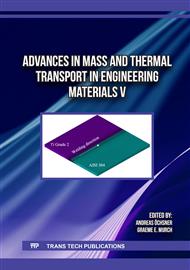[1]
S. Davoodi, M. Al-Shargabi, D. A. Wood, V. S. Rukavishnikov, and K. M. Minaev, "Experimental and field applications of nanotechnology for enhanced oil recovery purposes: A review," Fuel, vol. 324, p.124669, 2022.
DOI: 10.1016/j.fuel.2022.124669
Google Scholar
[2]
Y. Shiyi and W. Qiang, "New progress and prospect of oilfields development technologies in China," Petroleum Exploration and Development, vol. 45, no. 4, pp.698-711, 2018.
DOI: 10.1016/s1876-3804(18)30073-9
Google Scholar
[3]
K. E. Sapsford et al., "Functionalizing nanoparticles with biological molecules: developing chemistries that facilitate nanotechnology," Chemical reviews, vol. 113, no. 3, pp.1904-2074, 2013.
DOI: 10.1021/cr300143v
Google Scholar
[4]
Y. M. Hassan et al., "The influence of ZnO/SiO2 nanocomposite concentration on rheology, interfacial tension, and wettability for enhanced oil recovery," Chemical Engineering Research and Design, vol. 179, pp.452-461, 2022.
DOI: 10.1016/j.cherd.2022.01.033
Google Scholar
[5]
Y. M. Hassan, B. H. Guan, L. K. Chuan, M. F. Hamza, and S. Sikiru, "Effect of silica-based hybrid nano-surfactant on interfacial tension reduction for enhanced oil recovery," Chemical Engineering Research and Design, vol. 195, pp.370-377, 2023.
DOI: 10.1016/j.cherd.2023.05.050
Google Scholar
[6]
M. Singh, S. Singh, and A. M. Asiri, "IFT and friccohesity study of formulation, wetting, dewetting of liquid systems using oscosurvismeter," Journal of Molecular Liquids, vol. 244, pp.7-18, 2017.
DOI: 10.1016/j.molliq.2017.08.067
Google Scholar
[7]
M. I. Youssif and S. M. Saleh, "A macro and micro-investigation of nanotechnology for enhanced oil recovery: A comprehensive review," Journal of Molecular Liquids, p.125284, 2024.
DOI: 10.1016/j.molliq.2024.125284
Google Scholar
[8]
L. Hendraningrat, S. Li, and O. Torsæter, "A coreflood investigation of nanofluid enhanced oil recovery," Journal of Petroleum Science and Engineering, vol. 111, pp.128-138, 2013.
DOI: 10.1016/j.petrol.2013.07.003
Google Scholar
[9]
A. Ahmed, I. Mohd Saaid, R. M Pilus, A. Abbas Ahmed, A. H. Tunio, and M. K. Baig, "Development of surface treated nanosilica for wettability alteration and interfacial tension reduction," Journal of Dispersion Science and Technology, vol. 39, no. 10, pp.1469-1475, 2018.
DOI: 10.1080/01932691.2017.1417133
Google Scholar
[10]
A. Esfandyari Bayat, R. Junin, A. Samsuri, A. Piroozian, and M. Hokmabadi, "Impact of metal oxide nanoparticles on enhanced oil recovery from limestone media at several temperatures," Energy & fuels, vol. 28, no. 10, pp.6255-6266, 2014.
DOI: 10.1021/ef5013616
Google Scholar
[11]
L. Hendraningrat and O. Torsæter, "Metal oxide-based nanoparticles: Revealing their potential to enhance oil recovery in different wettability systems," Applied Nanoscience, vol. 5, pp.181-199, 2015.
DOI: 10.1007/s13204-014-0305-6
Google Scholar
[12]
E. Joonaki and S. Ghanaatian, "The application of nanofluids for enhanced oil recovery: effects on interfacial tension and coreflooding process," Petroleum Science and Technology, vol. 32, no. 21, pp.2599-2607, 2014.
DOI: 10.1080/10916466.2013.855228
Google Scholar
[13]
S.J.J. o. M.L. Sikiru, "Ionic transport and influence of electromagnetic field interaction within electric double layer in reservoir sandstone," vol. 344, p.117675, 2021.
DOI: 10.1016/j.molliq.2021.117675
Google Scholar
[14]
H. Soleimani et al., "Impact of carbon nanotubes based nanofluid on oil recovery efficiency using core flooding," Results in Physics, vol. 9, pp.39-48, 2018.
DOI: 10.1016/j.rinp.2018.01.072
Google Scholar
[15]
A. Aminian and B. ZareNezhad, "Wettability alteration in carbonate and sandstone rocks due to low salinity surfactant flooding," Journal of Molecular Liquids, vol. 275, pp.265-280, 2019.
DOI: 10.1016/j.molliq.2018.11.080
Google Scholar
[16]
T. Huhtamäki, X. Tian, J. T. Korhonen, and R. H. Ras, "Surface-wetting characterization using contact-angle measurements," Nature protocols, vol. 13, no. 7, pp.1521-1538, 2018.
DOI: 10.1038/s41596-018-0003-z
Google Scholar


